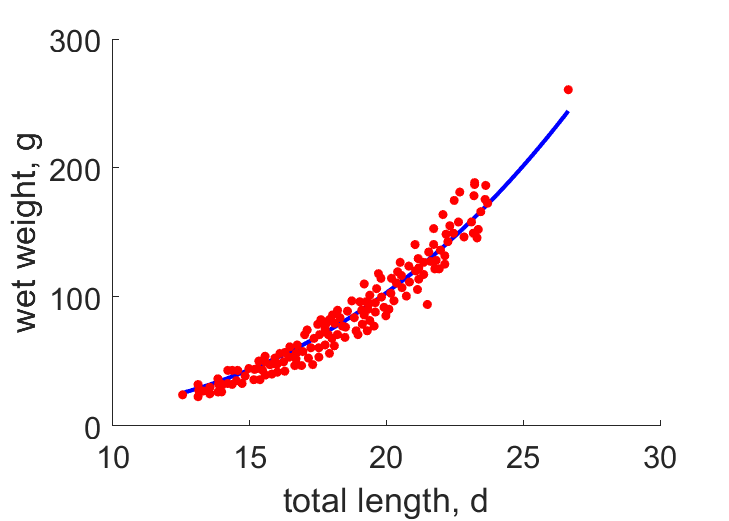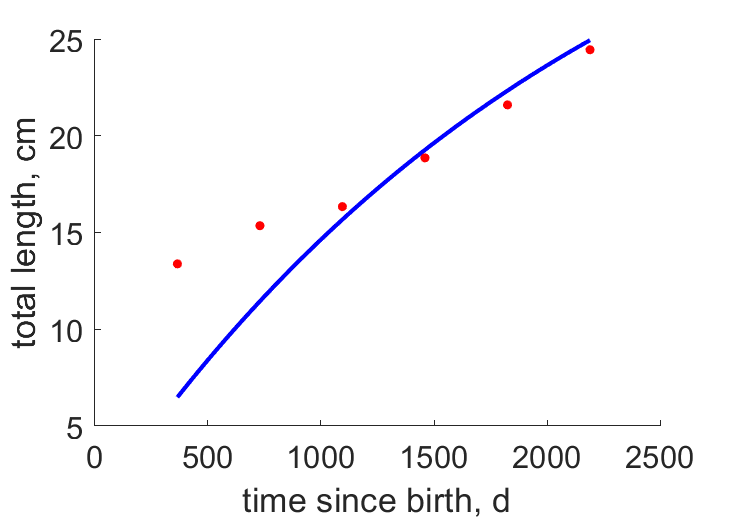Predictions & Data for this entry
| Model: abj | climate: Cfb, Dfb | migrate: Mp | phylum: |
| COMPLETE = 2.5 | ecozone: THp | food: biCi | class: |
| MRE = 0.151 | habitat: 0iFl, 0iFr, 0iFm | gender: D | order: |
| SMSE = 0.146 | embryo: Fh | reprod: O | family: |
Zero-variate data
| Data | Observed | Predicted | (RE) | Unit | Description | Reference |
|---|---|---|---|---|---|---|
| ah | 3 | 3.051 | (0.01704) | d | age at hatch | SchoBreu2006 |
| ab | 7.5 | 8.028 | (0.07038) | d | age at birth | SchoBreu2006 |
| tp | 1642 | 1474 | (0.1024) | d | age at puberty for females | SchoBreu2006 |
| tpm | 1278 | 1177 | (0.07847) | d | age at puberty for males | SchoBreu2006 |
| am | 3650 | 3675 | (0.006893) | d | life span | SchoBreu2006 |
| Lb | 0.75 | 0.648 | (0.136) | cm | total length at birth | SchoBreu2006 |
| Lp | 16 | 18.28 | (0.1422) | cm | total length at puberty for females | SchoBreu2006 |
| Lpm | 14 | 15.44 | (0.1025) | cm | total length at puberty for males | SchoBreu2006 |
| Li | 40 | 43.39 | (0.08473) | cm | ultimate total length | SchoBreu2006 |
| Wwb | 0.0038 | 0.003563 | (0.06245) | g | wet weight at birth | SchoBreu2006 |
| Ri | 274 | 7.369 | (0.9731) | #/d | max reprod rate | SchoBreu2006 |
Uni- and bivariate data
| Data | Figure | Independent variable | Dependent variable | (RE) | Reference |
|---|---|---|---|---|---|
| LW |  | total length | wet weight | (0.09574) | YilmYazi2015 |
| tL |  | time since birth | total length | (0.1192) | YilmYazi2015 |
| tW |  | time since birth | wet weight | (0.1218) | YilmYazi2015 |
Pseudo-data at Tref = 20°C
| Data | Generalised animal | Blicca bjoerkna | Unit | Description |
|---|---|---|---|---|
| v | 0.02 | 0.08184 | cm/d | energy conductance |
| p_M | 18 | 8.07 | J/d.cm^3 | vol-spec som maint |
| k_J | 0.002 | 0.0004751 | 1/d | maturity maint rate coefficient |
| k | 0.3 | 0.3084 | - | maintenance ratio |
| kap | 0.8 | 0.9752 | - | allocation fraction to soma |
| kap_G | 0.8 | 0.7988 | - | growth efficiency |
| kap_R | 0.95 | 0.95 | - | reproduction efficiency |
Discussion
- Males are assumed to differ from females by E_Hp only
Bibliography